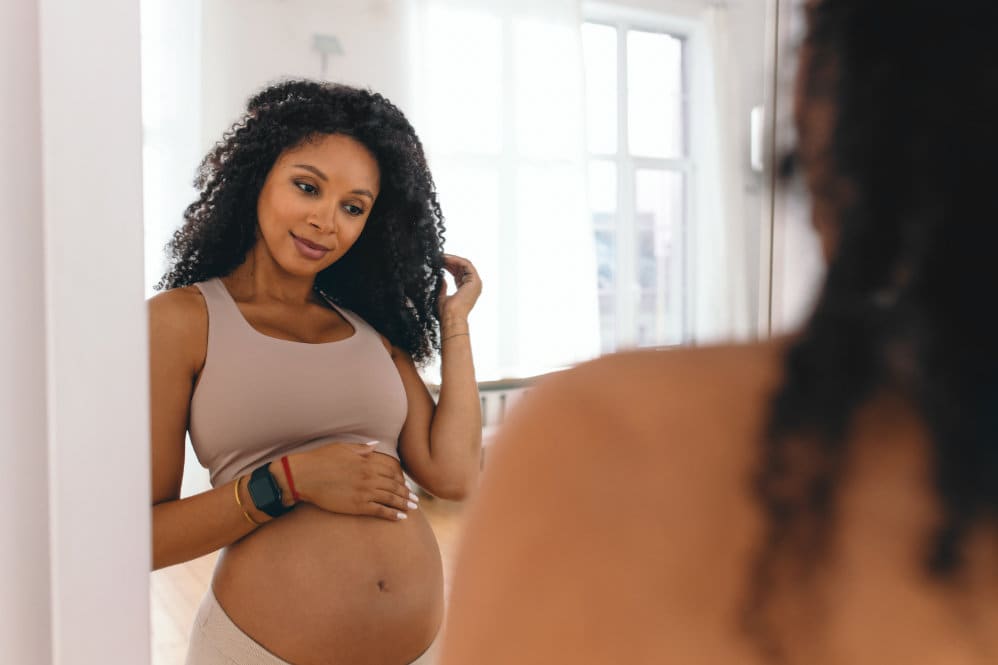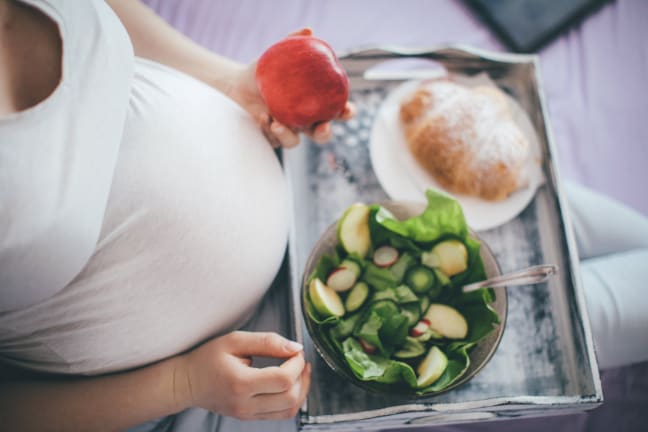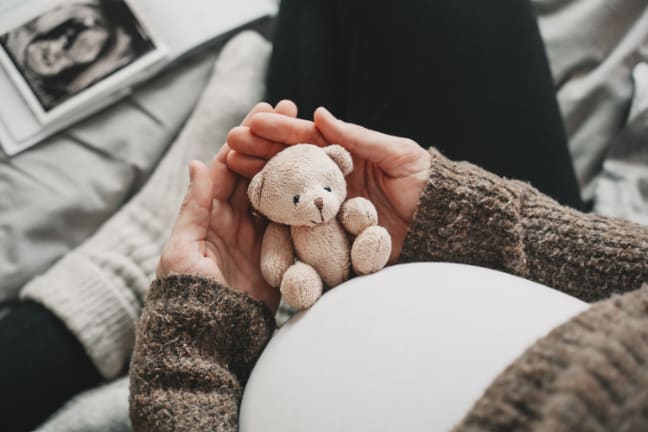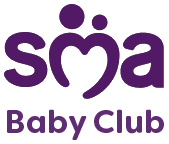Introduction
At week 31, baby is continuing to gain weight. By the time baby is born their weight would have doubled. Breasts feeling a little fuller? They are getting ready for feeding your little one. Feeling a weird tingling in your hands? It could be carpal tunnel syndrome, discover what to look out for and how to ease the symptoms in this article. You will need an extra 200kcals a day in your third trimester but spend them wisely. Learn more about what you should be eating in your third trimester and what to expect at 31 weeks pregnant.
What happens at 31 weeks pregnant?
The size of your baby at 31 weeks pregnant is around the size of a large coconut and getting heavier by the day. In fact, by the time they’re born, they’ll be twice this size, their weight will probably have doubled, and they’ll have grown a few more inches too. Hard to believe there’s enough room inside you for all this expansion!
Over the next few weeks baby will also be working out which direction they want to enter the world. With less room in there they will probably move more slowly and less often. If you’re worried about reduced movement make sure you talk to the hospital to make sure everything is ok in there.
Most babies go upside down – 95% of pregnancies are delivered this way with their faces looking down, their back against your stomach and their chin tucked in on their chest. This position is called head-first or cephalic and, more technically, occipito anterior – it’s the easiest and safest position for a baby to be delivered.
Other ways a baby can lie in the womb:
-
posterior position (occipito-posterior) - facing the opposite way with their back to your back, and their face upwards
-
breech position - where their bottom leads first, with their head at the top
-
transverse position - side to side, across your womb
At week 31 baby can be in any of these positions but should end up head-first around week 36. If your baby is still breech or transverse by this time, your midwife will talk to you about birthing options and how to plan for labour.
What happens to your body at 31 weeks pregnant?
Looking a bit fuller in the bust? Gone up a cup size? The big day is getting closer, so your breasts are preparing to feed your hungry little human. If you find yellow flecks on your top that’ll be colostrum. It’s the first milk you produce when you start breastfeeding, often described as liquid gold because it’s highly concentrated goodness. Find out more about breast milk and its amazing qualities.
The colostrum you give baby in their first few days contains the antibodies to boost tiny immune systems immediately after birth. If you’re lucky enough to produce this milk early on speak to your midwife about whether it’s worth trying to ‘harvest’ it for when baby arrives because you only produce a small amount at a time. Not all hospitals advocate this, so you may want to ask your midwife. Find out more about expressing milk.
Together with growing baby and growing breasts – mums to be can expect to put on 1kg to 1.5kg between now and birth.
What to eat at 31 weeks pregnant?
If you use sweetener as a sugar substitute then you may be wondering if it’s safe for baby. It’s been a hot topic for a few years and saccharine, in particular, gets a bad name. Although research on artificial sweeteners is not fully conclusive, aspartame- and sucralose-based sweeteners are considered safe during pregnancy if used in moderation. Whether or not they can help you lose weight is another matter, and they might actually encourage your sweet tooth. Try not to have foods or drinks with artificial sweeteners every day. It’s always preferable to use natural sweeteners whenever possible, by using fresh and dried fruit to get important nutrients in. You could add sliced strawberries or banana to plain yoghurt or make your own smoothies. That way you will be eating foods you know are healthy.
What are the symptoms of 31 weeks pregnant?
Week 31 pregnancy symptoms can include tingling sensation and numbness in your hands. Aches pains, tingling sensation and numbness in your hands can be caused by carpal tunnel syndrome. 60% of pregnant women may experience some symptoms of carpal tunnel syndrome and symptoms can vary from very mild to very painful and can affect one or both hands.
Swelling in your hands is caused by a build-up of fluid often known as oedema. The carpal tunnel is a narrow tunnel in your wrist, sometimes the fluid build-up can collect around the wrist joint and press on the nerves that go from the forearm and wrist through the carpal tunnel. Symptoms can include:
-
Numbness and tingling in the fingers, hands and wrist
-
Pain or throbbing in the fingers, wrist or forearm
-
Difficulty gripping objects or performing fiddly tasks
-
Hot swollen fingers and thumb
Symptoms are usually worst at night and first thing in the morning. Luckily there are some techniques you can use to help the symptoms:
-
Rest. Try and rest your hand and wrist on a pillow whenever you can, as overuse can make your symptoms worse
-
Elevation. When resting your hand and wrist try to keep it elevated by propping it up with a pillow. This will help to reduce the swelling
-
Ice. Apply a small ice pack to your wrist for 10 mins. A small bag of peas wrapped in a tea towel works well for this. Alternating between heat and cold can help. So, wrap a hot water bottle in a tea towel and alternate between hot and cold for one minute each, for five or six minutes.
-
Exercise. Although rest is important doing hand exercises may help ease symptoms
-
Support. Wearing a wrist splint at night can keep your wrist in a good position and relieve pressure on the nerve. You can get a wrist splint from your local pharmacy or online.
The symptoms of carpal tunnel syndrome usually disappear after your baby is born, however, if symptoms persist speak to your GP.
Diet for third trimester of pregnancy
Baby will put on an extra 1kg to 1.5kg between now and the big day, so your pregnancy diet may need a few adjustments.
Unfortunately, that doesn’t mean you get to eat loads of cake. You only need an extra 200 calories a day when you’re pregnant and that’s just in the third trimester. The trick is to make sure you are eating more nourishing and wholesome foods like nuts and fruit and less ‘empty calorie’ foods like crisps and chocolate. But no one is saying you can’t have a cheeky treat now and again.
Eating a rainbow of foods is a way of making sure you get a good variety. Lots of colourful veg – green spinach, yellow peppers, red tomatoes, purple aubergines… orange oranges. Also include complex (less processed, starchy) carbs, lean proteins, wholegrains and ‘good’ fats as part of your healthy pregnancy diet. It’s the best way to ensure that baby has all the necessary nutrients, without using any of the reserves you need for birth.
Iron is also important for baby’s cognitive development and vitamin C can help aid its absorption. So try and eat foods with those together at meal or snack times. Like citrus fruits with nuts. The great thing is, what you eat now can have a real and positive impact on your child's future health.




![inline_850_week-31.jpg 31-weeks-pregnant-belly]](/sites/default/files/2020-01/inline_850_week-31.jpg)






